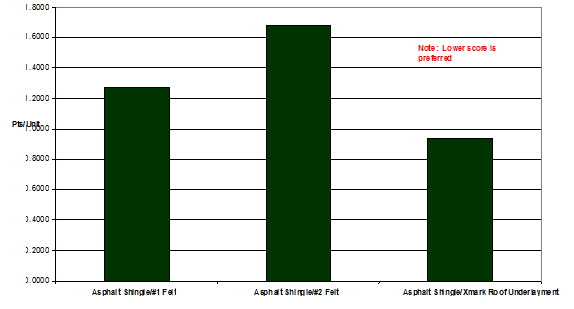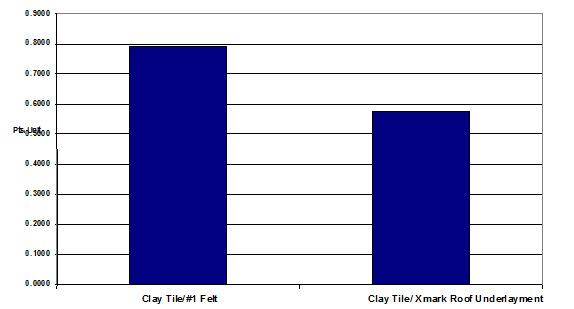|
|
Construction Products Technical Bulletin
|
The latest Buzz for Green Home Buyers and Builders:
Using Life Cycle Analysis (LCA) to Compare Building Products Alternatives
Abstract
A widely-accepted program for life cycle analysis (LCA) of building products has shown that Xmark Roof Underlayment is “greener”, i.e. does less damage to the environment that #15 or #30 asphalt-saturated felt. This conclusion is specific to Xmark Roof Underlayment and cannot be extended to synthetic roof underlayment from other manufacturers.
Introduction
Homebuilders and homebuyers across the continent are increasingly interested in green building. What exactly makes a building product green? Many manufacturers proudly declare their products as green without providing any data to back up their claim or without considering the whole life cycle of their product.
Green home builders and buyers need to be able to make practical green decisions based on environmental and energy analyses as well as cost considerations. However, because of a buildings considerable life expectancy, the decision making process should take into account the initial manufacturing and construction impacts and the impacts of replacement and final disposal through the use phase as well.
BEES (Building for Environmental and Economic Sustainability) is a widely-accepted program for life cycle analysis (LCA) of building products. BEES® was developed by the National Institute of Standards and Technology’s (NIST’s) Building and Fire Research Laboratory with support from the U.S. Environmental Protection Agency’s (EPA’s) Environmentally Preferable Purchasing Program.
LCA is a multi-faceted methodology not based solely on any one attribute that might give a particular product a green reputation (e.g. recycled content or renewable source). LCA measures the shift in environmental burdens from one life-cycle to another or one medium (land, air or water). Only by weighing all environmental impacts can users make the necessary decisions for achieving environmental benefits over the life of a building.
BEES® measures 12 separate environmental impacts for each product alternative. These impacts are:
-
Acidification (acid rain)
-
Criteria Air Pollution (primarily a measure of particulates)
-
Ecological Toxicity
-
Eutrophication (unwanted mineral nutrients assed to soil and water)
-
Fossil Fuel Depletion
-
Global Warming
-
Habitat Alteration
-
Human Health (cancer and non-cancer)
-
Indoor Air Quality (IAQ)
-
Ozone Depletion
-
Smog
-
Water Intake (amount used from cradle to grave)
The impacts above are weighted (using internationally recognized factors) to arrive at a Total Environmental Performance Score.
Study Results
NIST evaluated the Environmental Performance of roofing systems consisting of either asphalt shingles or clay tile in combination with #15 asphalt saturated felt underlayment, #30 asphalt saturated felt underlayment or Xmark Roof Underlayment.
The results are unequivocal and show that
1) Under asphalt shingles, Xmark Roof Underlayment imposes 44% less of a total environmental impact than #30 felt and 26% less of an environmental impact than #15 felt (see Chart 1).
2) Under clay tiles, Xmark Roof Underlayment imposes 27% less of a total environmental impact than #15 felt (see Chart 2).
These benefits (full details are available on request) are in addition to the performance benefits of Xmark Roof Underlayment including:
-
Xmark Roof Underlayment is less costly to install than asphalt saturated felt because it is lighter and has much greater coverage per roll
-
Xmark Roof Underlayment is water-proof and can be left exposed, if necessary, prior to installation of the final cladding
-
Xmark Roof Underlayment is stronger than asphalt saturated felt and resists tearing under windy conditions.
Conclusion
Architects, engineers, builders and owners who want to improve the environmental performance of their home and buildings routinely ask the question: “What material selections offer the best opportunity to optimize environmental benefits within my budget limit?” Scientifically-sound LCA techniques have shown that Xmark Roof Underlayment is the preferred choice over asphalt saturated felt.
Caution
These data and conclusions are specific to Xmark Roof Underlayment and cannot be extended to other brands of synthetic roof underlayment.
Chart 1.
Environmental Performance of Cladding/Underlayment Combination

Chart 2.
Environmental Performance of Cladding/Underlayment Combination

| 
 Items in Shopping Cart: 0
Items in Shopping Cart: 0  Total: C $0.00
Total: C $0.00 

 Items in Shopping Cart: 0
Items in Shopping Cart: 0  Total: C $0.00
Total: C $0.00 